![]()
![]()
![]()
Use LEFT and RIGHT arrow keys to navigate between flashcards;
Use UP and DOWN arrow keys to flip the card;
H to show hint;
A reads text to speech;
32 Cards in this Set
- Front
- Back
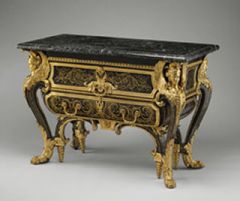
|
André Charles Boulle (än'drā chälz bōōl)
1642-1732 Boulle was a master cabinetmaker. He was discovered by Nicolas Fouquet who put him to work on his own chateau that he was building. He was so good at veneering and marquetry that his technique became named Boulle. His specialty inlay used tortoiseshell, German silver, brass or pewter. |
|

|
Andre LeNotre (än'drā lə'nō'trə)
(1613-1700) French architect and landscape architect that is best known for the gardens at Vaux le Vicomte and Versailles. LeNotre lived and worked in Paris his whole life, but his influence can be seen in gardens in Rome, Germany, and across Europe. LeNotre’s work is characterized by terraces, water basins, fountains, symmetry and geometric forms. He unified his compositions through the use of perspective – near and far elements were linked despite their distance. The gardens were not meant to be viewed all at once, but were designed to “unfold” as the user moved through them. |
|
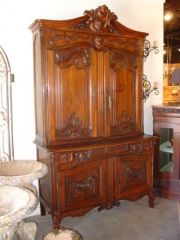
|
Armoire à deux corps (är mwär' à dö kôr)
A Renaissance cupboard having two parts. The lower, formerly only a supporting base, functioned as a larger cupboard, with a smaller cupboard set on top. It has all the attributes of the Louis XV style. The crown has a cartouche with a stylized shell, c-scrolls, and trailing foliage with rosettes are on either side. The freize has a central mask of a smiling young woman with rinceau to either side. The upper recessed cabinet, with two doors and pewter hinges, has fluting, acanthus leaves, rosettes, scrolling foliage, scalloped shells, banding surrounding raised conforming center panels. |
|

|
Banderole (ban'də rōl)
Use began in the Gothic period and became more regular in the early Renaissance. This decorative ribbon motif can either be carved into a surface and used architecturally, or it can be used to enhance a painting. Usually the ribbon bears an inscription and is used to relay a message about the piece that it’s found within. In painted works, the banderole appears as a 3-dimensional object and declined in use due to the desire for realism in Renaissance art. |
|
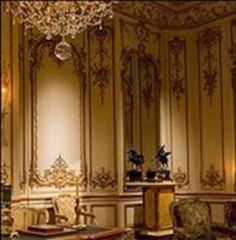
|
Boiserie (bwä'zə rē')
A French word for carved wood paneling. Boiserie became popular during the French Baroque time period when it was used to cover the lower portions of wall emphasizing horizontality, similar to wainscoting. It was also seen in the French Rococo during both the Regence and Louis XV time periods where it often covered the entire wall. When first used, boiserie were left unpainted, but later the raised areas were often painted or gilded. |
|
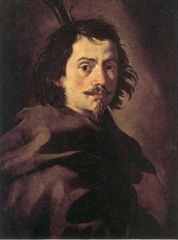
|
Francesco Borromini (frän ches'kô bô'rô mē'nē)
(1599-1667) Architect and sculptor in Rome; He studied architecture under Carlo Maderna and Bernini. Characteristics of his work were innovations for ecclesiastical structure with a creative force. His most famous works were: San Carlo alle Quattro Fontane, S. Ivo alla Sapienza, Palazzo Barberini spiral staircase, Palazzo Spada and other smaller projects. |
|
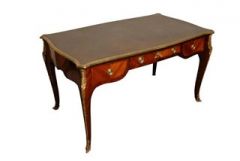
|
Bureau plat (byoor'ō plät)
A writing table that was among the great variety constructed in the Louis XIV period. This table incorporated three drawers in the frieze; often the center drawer was recessed. The bureau plat was constructed with cabriole legs (also known as “S-scrolls”). Though the bureau plat was introduced during the reign of Louis XIV, it became more important during the reign of Louis XV (during the French Rococo). Tables of this time period are often characterized by their tooled leather surface rather than the wooden tops seen previously. |
|
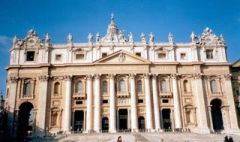
|
Carlo Maderno (kär'lō məd'ar'nō)
(1596-1629) Carlo Maderno is considered to be a highly influential architect and significant contributor to the Baroque style. He was born in Switzerland and moved to Rome in 1588. Maderno began his career as a marble cutter which gave him the skills set for sculpture and form. Most known for his façade design on Santa Susanna, St. Peter’s Basilica, and Sant’Andrea Della Valle. The façade of St. Peter’s Basilica was finished in 1603 and is considered to be the first Baroque façade. Maderno brought simplicity into the façade of structures and would build up to a climax at the center with an incorporation of sculpture and decorative elements. |
|
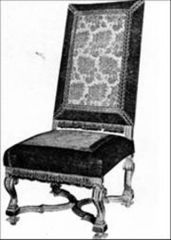
|
Chaise (shāz)
The chaise has similar characteristics to the fauteuil except it is armless. Chair protocol dictated the height of the chair; the chaise was mid-rank. Forms of the chaise became lighter scaled and delicately curved during the late Louis XIV period. Legs of the chair were originally turned as columnar, knobbed, or baluster, but during the reign of Louis XIV, carving became prominent. It has a tall, square back that is separated from the square seat. The chair was fully upholstered, typically with baluster or pedestal, carved legs and X or H-shaped cross stretchers. |
|
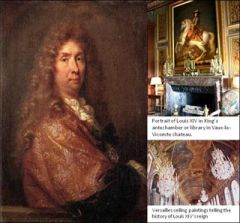
|
Charles LeBrun (shärl lə brën)
(1619-1690) Charles LeBrun was a French painter and designer of the French Baroque period during the reign of Louis XIV. He is famous for his design of Versailles and played a major part in creating a unique and unified national style called the Louis Quatorze. LeBrun originally was the chief decorator for the Vaux-le-Vicomte. Louis XIV saw his work and hired him as the primary coordinator at Versailles. Louis XIV also gave him the title “Principal painter to the king,” and LeBrun became responsible for designing models of furniture and decoration to be used within the Louvre as well as for the king’s furniture manufacture. |
|
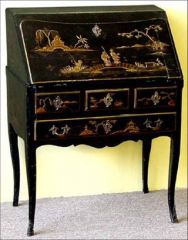
|
Chinoiserie (shēn wä zə rē')
A style of ornamentation found in 18th century Europe which was characterized Chinese patterns and motifs. They could be found in interiors, pottery, gardens, furniture, etc. This was a time when trading efforts between Europe and Asia were reaching their peak. The motifs can be described as picturesque and imaginative. |
|
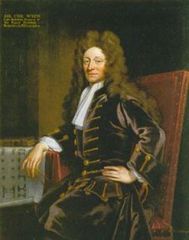
|
Christopher Wren (ren)
(1632-1723) One of the greatest English architects to ever live. He was also an English designer, mathematician, astronomer, and geometer. Sir Christopher Wren designed 53 churches in London. He is most noticeably known for the design of St. Paul’s Cathedral. His designing affected the space planning, interior architecture, furniture design, and decorative detail of that time period. |
|
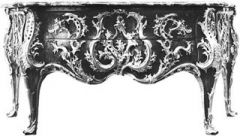
|
Commode (kə mōd')
Most commodes had (green) marble tops, and some were fitted with pairs of doors. They originated during the Louis XIV: France in the late 17th century André-Charles Boulle was among the first to make commodes. Early forms resembled sarcophagi and were commonly called commodes-tombeau. Although most French cabinet furniture at the beginning of the 18th century was heavy in form, outlines were gently curved, the sides of commodes being slightly convex, or bombé and the front serpentine. |
|
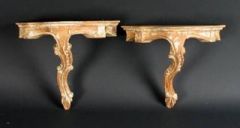
|
Console (kän'sōl')
A bracket, typically in an S scroll or curve. Consoles are used to support a cornice, shelf or table top in the case of a console table. A console table is really just a shelf that is supported by a console. Consoles were used in the 17th century as a means of treating the entablature. LeBrun introduced the use of pairs of consoles in friezes. |
|
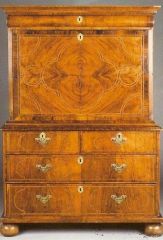
|
Crossbanding
Crossbanding is a technique used on case pieces consisting of narrow bands of veneer used to frame a panel; the grain direction of this border is perpendicular to the grain of the wood surface it surrounds. Popular during the 18th century in England. |
|
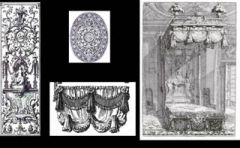
|
Daniel Marot (dan'yəl mär'ō)
(1661-1752) A French-born architect, designer of furniture and engraver who worked mainly in England and Holland. He published many influential designs for furniture, decorative objects and interiors. Trained by his father, his engravings are used for record of contemporary fashions in interior design. These include designs for carriages, clocks, paneling, beds and embroidery. |
|
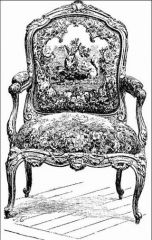
|
Fauteuil (fō-’tœy or ‘fō'til)
A French armchair with upholstered back and seat. Arms are open and can also be upholstered on the horizontal portion where the arms rest. |
|
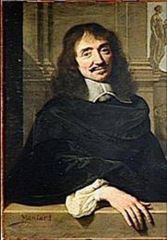
|
Francois Mansart (frän-swa män'sar)
(1598-1666). Francois is one of the first French architects to embrace classicism in France. He was knowledgeable in using classical orders, restrained detail and harmonious proportions. Francois Mansart primarily practiced architecture in Paris, France where he designed numerous town houses. Mansart’s best known design is the Chateau of Maisons (1641-1646) As a young architect Francois was commissioned primarily by wealthy officers of the Crown, to design both new structures and plans for rebuilding existing châteaux. It is consistently believed that Francois Mansart had difficulty in accommodating social norms. He was viewed as stubborn and a perfectionist to a fault, tearing down his structures only to start building them over again. |
|
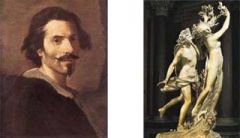
|
Giovanni Lorenzo Bernini (jô vän'nē lô ren'tsô ber nē'nē)
(1598-1680) Bernini was a sculptor, painter and architect and a formative influence as an outstanding exponent of the Italian Baroque. He was well known for sculpting figures that appeared to be captured in a moment, or in motion. His sculptures were incredibly detailed and his well-known ability to manipulate marble, made him famous. The movement in his sculptures forced the viewer to walk around the piece to get the full effect. Along with sculptures, he is also known as the godfather of water fountain design (garden fountains 1). An architect of churches, he is best known for embellishing pre-existing buildings, as opposed to building new ones. |
|

|
Grinling Gibbons (grin'ling gib'ənz)
(1648-1721) Grinling Gibbons was a sculptor during the English Baroque. In his early years as a sculptor he spent time in Holland and after catching the eye of architect Hugh May and was given a commission. As a result, he moved to England in 1667 and carried out his career there. He was an elaborate wood carver and his work was portrayed in palaces, churches and country homes throughout England. His work can be found in St. Paul’s Cathedral, Hampton Court Palace, Kensington Palace in London, and Blenheim Palace in Oxfordshire. He invented the “trophy panel," a freestanding carved tableau that situates itself between a painting and a sculpture. |
|

|
Highboy
A high or double chest of drawers on legs.It is also known as a chest-on-stand or a chest-on-chest. The name highboy is derived from a corruption of the French bois (“wood”). The highboy in later life became very ornate usually including a carved scrolled bonnet top. |
|
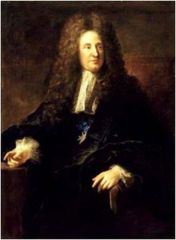
|
Jules Hardouin-Mansart (jōōlz är'dwan män'sar)
(1646-1708) Jules Hardouin-Mansart was born in Paris, France in 1646. He trained under his great uncle, Francois Mansart. When Francois Mansart died, Hardouin inherited an enormous collection of plans and drawings which he later utilized in his own designs. He also assumed his great uncle's last name. Hardouin-Mansart served as the royal architect and city planner to King Louis XIV starting in 1675. He eventually served as premier architect and then superintendent of buildings. During his career, he created many significant monuments of the period. He represented the age of Louis XIV with architectural structures that conveyed the king's wealth and power. He designed his buildings with imposing scale and understated simplicity. |
|
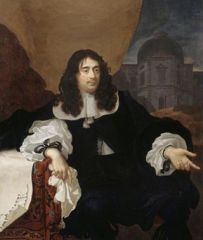
|
Louis Le Vau (lōō'ē lə vō)
(1612 – 1670) Le Vau was a French architect and one of the principal designers of the Palace of Versailles. After designing numerous private houses and mansions, including the Château de Vaux-le-Vicomte, he began work on Versailles in 1669. Supervising a brilliant array of artisans, he was responsible for the central block and garden façade, notable for its noble classical proportions and overpowering scale. Le Vau's interiors, particularly the Ambassador's Staircase (destroyed 1752), had an architectural grandeur and Baroque ornateness that exceeded any comparable interiors of the time. |
|
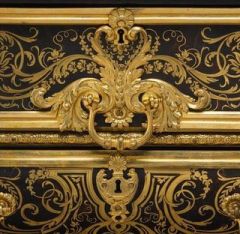
|
Ormolu Mounts (ôr'mə-lū')
Applied decoration on furniture, which is typically gilded bronze. The surface is usually hand chased and surfaced with gilt. Any combination of copper, zinc or tin can be used and the end result resembles gold. We first see this term used during the French Baroque period in reference to the construction techniques of furniture in the 16th an 17th century. Ormolu mounts were designed to protect the edges of Boulle-work because this technique was so fragile. |
|
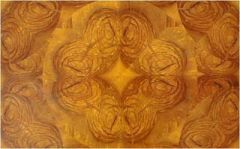
|
Oysterwork (ois'tər wʉrk)
A surface embellishment comprised of transverse cuts of branches, placed into a ringed pattern, revealing the annual rings of the tree. Oysterwork was often used along with marquetry in a overall design for furniture pieces of the English Baroque. |
|
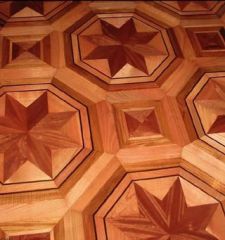
|
Parquet (pär'kā')
An inlaid wood floor, or a mosaic wood floor, with a design created by strips of wood laid out in a definite pattern. Parquet floors were first introduced during the French Renaissance period. These floors were later incorporated into French Baroque interiors becoming more popular as the 17th century progressed. Parquet floors were also used in English Baroque interiors but not nearly as often as in the French. |
|
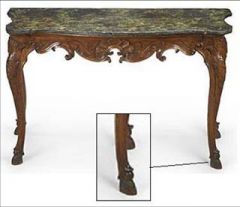
|
Pied de biche (pyā də bēsh)
French for a deer’s foot. A decorative hoof-shaped foot as the termination to a leg; consisting of a slight outward curve ending in the resemblance of a cloven hoof. Used on chairs and tables during the late renaissance and France’s Baroque and Rocco periods. First used to reference this furnishing element in the late renaissance and gained popularity moving into the baroque period. No source was able to place a date to the origin as it is a direct translation from the French language that over time evolved into a design term associated with the French Baroque periods. |
|
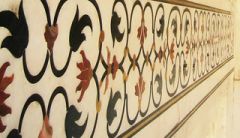
|
Pietra dura (pyā'trä dōōr'ə)
A technique of using small, exquisitely cut and fitted, highly-polished colored stones to create what amounts to a painting in stone, usually for cabinet panels, tabletops and so on. It was first introduced during the late 16th century in Italy, during the Italian Baroque period. The center of this art-form was in Florence. Pietra dura is a decorative stonework, that is first assembled loosely, then is glued stone-by-stone to a substrate (often marble) after having previously been sliced and cut into different shaped pieces. The stonework is assembled together so precisely that the contact between each section is practically invisible. |
|
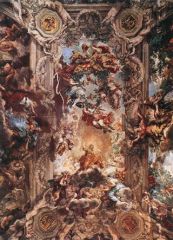
|
Pietro da Cortona (pyā'trō dä côr'tōnä)
(1596–1669) Pietro da Cortona, also known as Pietro Berrettini, was an Italian painter of High Baroque. He studied in Florence and then Rome, learning to paint primarily by teaching himself. He is best known for painting fresco ceilings. He also practiced architecture, and although he considered it only a hobby, he was considered second only to Gian Lorenzo Bernini among 17th century Roman architects. Pietro’s most important fresco’s were painted for the highly influential Barberini family. His most famous fresco, on the ceiling of the Barberini Palace, is the Allegory of Divine Providence and Barberini Power. |
|
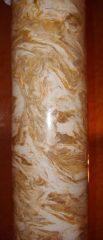
|
Scagliola (skal yō'lə)
An imitation of any veined and ornamental stone, such as marble or granite. This is formed by a substrate of finely ground gypsum mixed with glue, the surface of which, while soft, is variegated with splinters of marble, spar, granite, etc., and subsequently colored and polished. Scagliola is a finish technique which replaced Pietra Dura, a type of mosaic using colored stones, in the late 17th century. It was used on architectural features such as columns and sculptures to imitate marble because it was too costly to use the actual materials. This technique can also be used to immitate marble inlays on items such as tables and cabinet doors. |
|
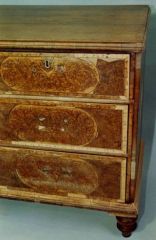
|
Seaweed Marquetry (sē'wēd mär'kə trē)
An inlay pattern of arabesque, small leaves, or seaweed patterns. This pattern was typically symmetrical and was common during the William and Mary and the Queen Anne periods in England. The inlay was often created out of a variety of woods. It took exceptional skill to develop these intricate intertwining foliage forms. Often found on tables and storage pieces of furniture. |
|
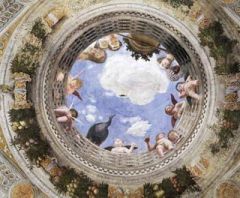
|
Sotto in su (sät'ō in sōō)
Sotto in su is a drawing or painting technique that exhibits trompe l’oeil and other perspective tools such as extreme foreshortening of figures painted on a ceiling or other high surface so as to give the illusion that the figures are suspended in air above the viewer. Although this technique originated during the renaissance, it was first commonly used within Italian Baroque fresco cycles. |

